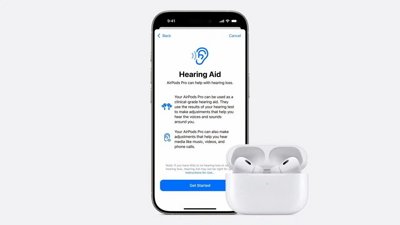Apple headphones are increasingly popular thanks to their system integration and iconic design. The AirPods brand has become synonymous with true-wireless earbuds, just as Beats has remained a strong premium brand for years.
Both AirPods and Beats by Dre are priced well above the cheapest headphones on the market. It is relatively simple to find functional wireless earbuds for well under $50, while AirPods start at $129 new.
Even the Beats brand doesn't offer any product in the sub-$50 range. However, as with most Apple products, that higher entry price has earned those brands a reputation for being more premium.
Apple used to include a set of wired earbuds called EarPods in the iPhone box — first with a headphone plug, then a Lightning connector. These stopped being offered after the AirPods were announced as an upsell to purchase the more premium earbuds.
There are multiple Apple headphones for sale today under the two brands AirPods and Beats by Dre. Learn about how these products have evolved over the years below, or dive into each product's specs and features via the quick links above.
AirPods
The original set of AirPods and the second generation that followed are Apple's iconic white-stemmed wireless earbuds. The long white stems are a signature marker of the product, though perhaps now a social signifier that someone owns the "old" pair.
Apple still sells the second-generation model, though in a non-wireless charging case, for $129. They use the H1 processor and have a five-hour battery life.
Despite being ridiculed for their design in 2016, they quickly became status symbols. Younger customers especially flocked to the earbuds, making them practically impossible to keep on store shelves for some time.
Now, it isn't unusual to spot AirPods in use everywhere, from grocery stores to Zoom calls on talk shows. However, since Apple has iterated on the original with a redesigned third-generation model and higher-end pro earbuds, the status symbol quickly shifted to more expensive Apple headphones.
AirPods Pro
The AirPods Pro arrived in 2019, only a few months after the second-generation AirPods were revealed. They used the new H1 chip that replaced the W1 chip, had a shorter stem, and offered replaceable ear tips.
However, the design change wasn't enough to warrant the "pro" name. Apple also included Active Noise Cancelation, Transparency mode, and additional features to make the $250 earbuds more palatable.
Active Noise Cancelation and Transparency Mode weren't novel features in earbuds. Apple headphones competitors like Bose and Sony had already gained a vocal fanbase for their earbuds. However, Apple's deep technology integration made AirPods Pro stand out.
Owners of the original generations of AirPods began to see their batteries become exhausted after the AirPods Pro were announced. This led to a substantial upgrade cycle over the three years before the second-generation model was released.
During the second-generation announcement in 2022, Apple CEO Tim Cook revealed that the original AirPods Pro had become the company's most popular model. Though, AirPods Pro are not the most premium model it offers.
AirPods Max
Apple announced the AirPods Max in December 2020. They are still sold for $550, and there aren't any signs of a second-generation model yet.
These over-the-ear Apple headphones are an odd product in the lineup as they are the only non-earbud product named AirPods. The company used the AirPods brand due to the technology stack, like the H1 chip and ecosystem integrations.
AirPods Max are the only AirPods sold in multiple color options and have magnetically attached ear pads, aluminum ear cups, a stainless steel headband, and a silicone canopy. It even has a Digital Crown for controlling volume.
These hyper-premium headphones are more expensive than any Beats headphones. As a result, they compete with high-end consumer brands that generally offer more sound fidelity and less technology.
Some speculate the AirPods Max is a one-off product that won't be updated again. However, since the original set uses Lightning to charge, Apple can update them with USB-C in 2023 to keep them relevant.
Despite the high price, analysts haven't deemed AirPods Max a complete flop. On the contrary, the headphones act as another status icon, and Apple cannot help but ensure they show up at media events or on sports announcers' heads during Friday Night Baseball.
Apple wouldn't introduce another set of AirPods until 2021 with a redesigned set of earbuds.
AirPods 3
AirPods 3 stand out as a new product because of their physical redesign. They take on design elements first introduced in AirPods Pro but keep the one-size-fits-all shape of the original.
The earbuds are more bulbous but don't have exchangeable ear tips. Tap gestures are gone in favor of the Force Sensor.
The AirPods 3 don't have ANC or Transparency Mode, so there is still reason to purchase the more premium model.
Most importantly, the AirPods 3 changed the price lineup. They are $179 with the MagSafe Charging Case and drove the price of the older set down to $129.
It isn't clear how this now middle-model is selling. Apple's price structures incentivize consumers to target the entry or premium models, with the AirPods 3 acting as a ladder rung between the two.
Many users argued that new buyers should only look to the aging AirPods Pro for the premium ANC and Transparency modes. If those weren't a priority, the AirPods 3 were more than enough, at least until the new pro models arrived.
AirPods Pro 2
Rumors suggested that AirPods Pro 2 were "ready" to ship for a while, but supply chain issues and other internal problems pushed them out by months. As a result, by the time the second-generation model arrived in 2022, day-one adopters of the original pair were on their last leg of battery power.
The design didn't change for the AirPods Pro 2. However, thanks to advances in the new H2 processor, the feature set anecdotally doubled in value.
The Active Noise Cancelation feature was now twice as good, even according to Apple. And Adaptive Transparency brought a new level of natural listening to users.
Battery life was extended by an hour and a half to six hours, the charging case offers up to 30 hours of listening, and the Charging Case gained MagSafe. Apple also included an external speaker and U1 chip in the case for easier finding via Find My.
The price remained the same at $250. Apple's next set generation of AirPods is expected to include USB-C.
Beats by Dre
Apple purchased Beats by Dre in 2014 for its fledgling music service, Beats Music. It evolved that music platform into Apple Music while keeping the popular headphone brand alive as a subsidiary.
Surprisingly, the hardware lineup remained mainly under the control of the subsidiary, with only light touches from Apple. Despite Apple's control over the technology stack, the design, logo, and Android-friendly features remained. Even Beats' signature bass-heavy sound stuck around.
The over-the-ear headphones offered by Beats are designed identically to their pre-Apple versions beyond a W1 chipset — micro-USB charging included. Apple still sells them at full price, though many companies sell them at heavy discounts.
The Beats Solo3 were revealed in 2016 and are currently sold for $200. The Beats Studio3 were announced in 2017 and are still sold at the launch price of $350. Unfortunately, Beats and Apple haven't shown any signs of updating these aging headphones, likely because Apple wants customers to buy the high-end AirPods Max instead.
The Beats earbud lineup has seen radical changes in the last decade as they shifted to Apple's wireless technology. Nearly every model available today uses Apple's W1 or H1 chipset, has USB-C charging, and works across iOS and Android.
The Powerbeats Pro were introduced in 2019 with an H1 chip and a Lightning-based charging case. These $250 earbuds are still for sale but are likely the last of their kind, thanks to improved earbuds taking their place.
The modern lineup of Beats earbuds that are promoted heavily come in three varieties — Beats Fit Pro, Beats Studio Buds, and Beats Flex.
The Beats Fit Pro are the current flagship Beats earbuds with an H1 chip, USB-C, ANC, and in-ear design. They are $200 and available in seven colors.
The Beats Flex act as the entry model for Beats at $70. They use the W1 chip, charge via USB-C, and offer 12 hours of listening time.
The Beats Studio Buds are a middle option meant to appeal to Android and Apple users at $150. They don't have a proprietary Apple processor but have ANC, Transparency mode, and one-touch pairing for Apple and Android products.
An updated set of Beats Studio Buds are expected to release in May 2023. They will have 1.6x improved ANC and 2x improved Transparency mode thanks to 3x larger microphones, alongside the usual set of features and a transparent color option.
Speculation assumed Apple would eventually shutter Beats entirely in favor of its AirPods lineup. It isn't clear if that will ever be the case, as Apple headphones are sold under two of the most popular brands on the planet, and eliminating one in favor of the other doesn't make sense.
The Beats over-the-ear headphone category might disappear unless Apple moves the line to USB-C and H1 processors soon. The Beats speaker lineup has been discontinued, but artist collaborations occasionally revive the $230 Beats Pill+.
EarPods
Before AirPods, there were EarPods — Apple's wired earbuds included in every iPhone box. These earbuds have a long history at the company that goes back to iPod in 2001.
Apple headphones became an iconic piece of pop culture thanks to silhouette ads featuring the white earbuds. The original set shipped with the iPod and didn't have an official name. They featured round white ear tips with a large speaker grille.
The EarPods name didn't arrive until 2012 with a redesigned one-size-fits-all ear tip. This model shipped with the iPhone 5 and various then-new iPods like the iPod touch and iPod nano.
The EarPods abandoned the 3.5mm headphone plug at the same time Apple did with the iPhone 7's jack in 2016. Apple shipped the EarPods with a Lightning connector in the iPhone box until the iPhone 12 in 2020.
Apple still sells both versions of the EarPods, one with a 3.5mm headphone plug and another with a Lightning connector. They are both $19 (on sale at Amazon).
Despite being over 20 years old, the iconic white earbud look has survived the test of time. This is likely why the only set with color options is an over-the-ear headphone, not earbuds.
Apple headphones price points & deals
Shoppers looking to purchase a pair of AirPods or Beats can find steep savings on nearly every model using the AppleInsider Apple headphones price comparison tool. Updated daily, the Price Guide tracks discounts across leading Apple resellers like Amazon, B&H and Best Buy.
Using the guide, bargain hunters can regularly pick up a pair of AirPods for under $100 and save up to $150 on Beats in-ear and over-ear styles. There are always deals on various Apple headphones, so keep an eye on AppleInsider price guides.
















 Amber Neely
Amber Neely
 William Gallagher and Mike Wuerthele
William Gallagher and Mike Wuerthele
 Marko Zivkovic
Marko Zivkovic

 Malcolm Owen
Malcolm Owen
 Christine McKee
Christine McKee



